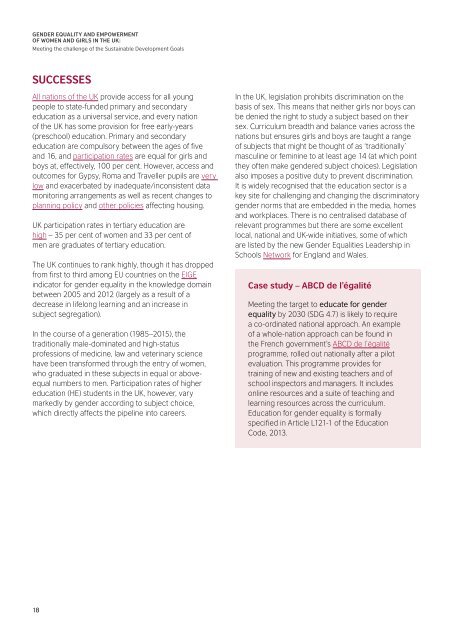GENDER EQUALITY AND EMPOWERMENT OF WOMEN AND GIRLS IN THE UK
gender_equality_an_empowerment_in_the_uk
gender_equality_an_empowerment_in_the_uk
Create successful ePaper yourself
Turn your PDF publications into a flip-book with our unique Google optimized e-Paper software.
<strong>GENDER</strong> <strong>EQUALITY</strong> <strong>AND</strong> <strong>EMPOWERMENT</strong><br />
<strong>OF</strong> <strong>WOMEN</strong> <strong>AND</strong> <strong>GIRLS</strong> <strong>IN</strong> <strong>THE</strong> <strong>UK</strong>:<br />
Meeting the challenge of the Sustainable Development Goals<br />
SUCCESSES<br />
All nations of the <strong>UK</strong> provide access for all young<br />
people to state-funded primary and secondary<br />
education as a universal service, and every nation<br />
of the <strong>UK</strong> has some provision for free early-years<br />
(preschool) education. Primary and secondary<br />
education are compulsory between the ages of five<br />
and 16, and participation rates are equal for girls and<br />
boys at, effectively, 100 per cent. However, access and<br />
outcomes for Gypsy, Roma and Traveller pupils are very<br />
low and exacerbated by inadequate/inconsistent data<br />
monitoring arrangements as well as recent changes to<br />
planning policy and other policies affecting housing.<br />
<strong>UK</strong> participation rates in tertiary education are<br />
high – 35 per cent of women and 33 per cent of<br />
men are graduates of tertiary education.<br />
The <strong>UK</strong> continues to rank highly, though it has dropped<br />
from first to third among EU countries on the EIGE<br />
indicator for gender equality in the knowledge domain<br />
between 2005 and 2012 (largely as a result of a<br />
decrease in lifelong learning and an increase in<br />
subject segregation).<br />
In the course of a generation (1985–2015), the<br />
traditionally male-dominated and high-status<br />
professions of medicine, law and veterinary science<br />
have been transformed through the entry of women,<br />
who graduated in these subjects in equal or aboveequal<br />
numbers to men. Participation rates of higher<br />
education (HE) students in the <strong>UK</strong>, however, vary<br />
markedly by gender according to subject choice,<br />
which directly affects the pipeline into careers.<br />
In the <strong>UK</strong>, legislation prohibits discrimination on the<br />
basis of sex. This means that neither girls nor boys can<br />
be denied the right to study a subject based on their<br />
sex. Curriculum breadth and balance varies across the<br />
nations but ensures girls and boys are taught a range<br />
of subjects that might be thought of as ‘traditionally’<br />
masculine or feminine to at least age 14 (at which point<br />
they often make gendered subject choices). Legislation<br />
also imposes a positive duty to prevent discrimination.<br />
It is widely recognised that the education sector is a<br />
key site for challenging and changing the discriminatory<br />
gender norms that are embedded in the media, homes<br />
and workplaces. There is no centralised database of<br />
relevant programmes but there are some excellent<br />
local, national and <strong>UK</strong>-wide initiatives, some of which<br />
are listed by the new Gender Equalities Leadership in<br />
Schools Network for England and Wales.<br />
Case study – ABCD de l’égalité<br />
Meeting the target to educate for gender<br />
equality by 2030 (SDG 4.7) is likely to require<br />
a co-ordinated national approach. An example<br />
of a whole-nation approach can be found in<br />
the French government’s ABCD de l’égalité<br />
programme, rolled out nationally after a pilot<br />
evaluation. This programme provides for<br />
training of new and existing teachers and of<br />
school inspectors and managers. It includes<br />
online resources and a suite of teaching and<br />
learning resources across the curriculum.<br />
Education for gender equality is formally<br />
specified in Article L121-1 of the Education<br />
Code, 2013.<br />
18


